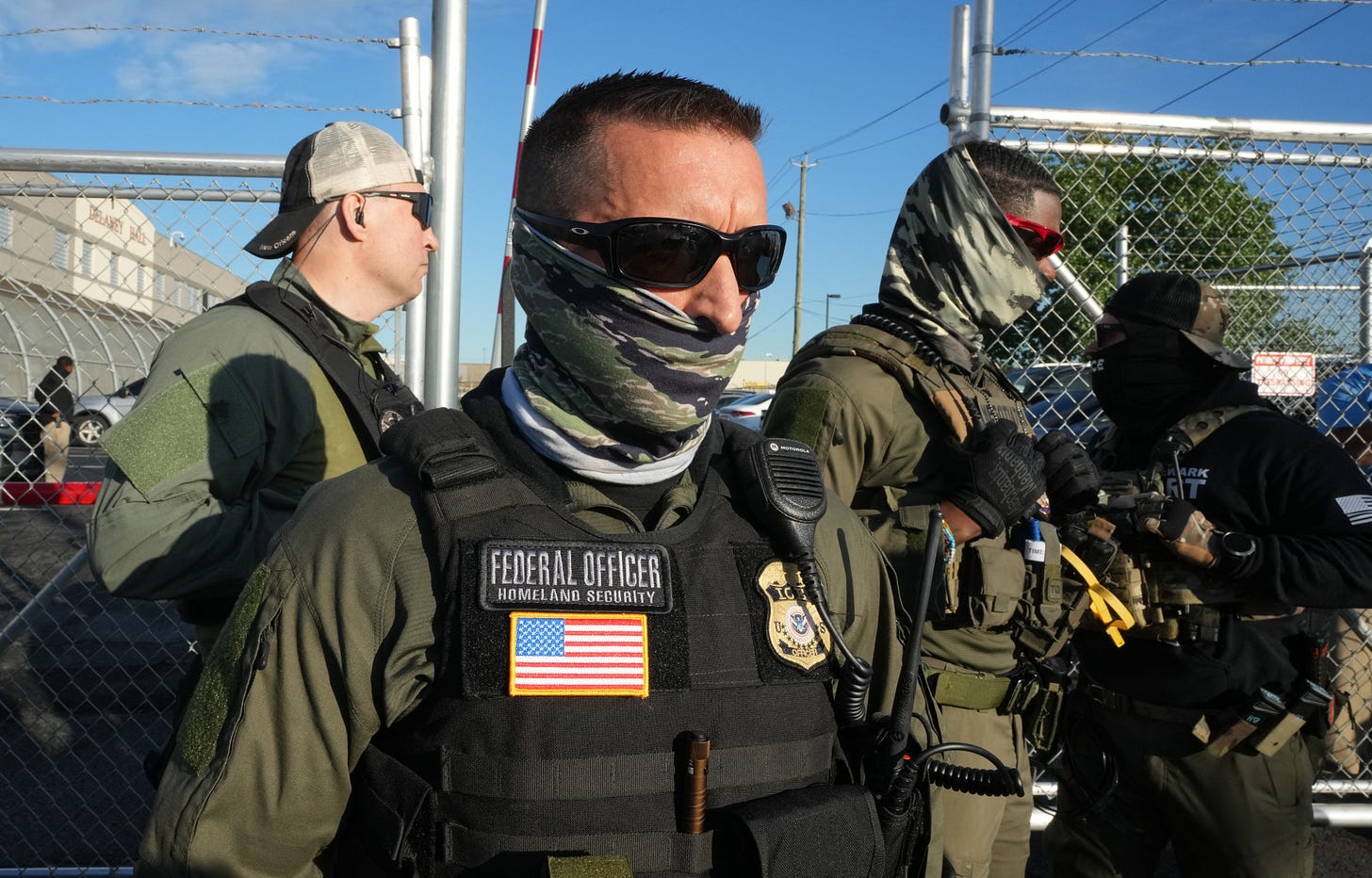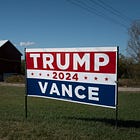Trump is withdrawing whiteness from white immigrants
He believes America is only for citizens who are white and whites who are citizens.
🛂 With corporate outlets obeying in advance, supporting independent political media is more important right now than ever. PN is possible thanks to paid subscribers. If you aren’t one already, please click the button below to sign up and support our work. 🛂
Earlier this month, Fabian Schmidt, a German national and a US permanent resident, was released after two months in ICE detention.
Schmidt, who has lived in the US since 2007, was detained by ICE at Boston’s Logan Airport, apparently because of a dismissed misdemeanor marijuana offense. Schmidt’s family says he was “violently interrogated” at Logan. He was reportedly forced to remove his clothes, given a cold shower, denied access to anxiety medication, and kept awake until he collapsed and had to be taken to the hospital.
ICE overreach, violence, and lawlessness is not surprising. But the target of that violence and lawlessness in this case, and in other similar ones, may be a little unexpected. Schmidt is white. So are many others who have run afoul of Trump’s new immigration regime. As Ryan Cooper, the managing of the American Prospect, pointed out, “I did not anticipate ICE goons going after the whitest possible immigrants with American families, jobs, and in good standing legally.”
Cooper’s confusion is understandable. During his latest campaign, President Donald Trump made a point of signaling out non-white immigrants for demonization. He especially targeted Haitian immigrants in Ohio for vile racist slurs. He’s used racist smears against Mexican immigrants since his first campaign in 2016. And of course, Trump this month welcomed white South African immigrants who he falsely claims are refugees from anti-white violence. In a televised meeting with South African President Cyril Ramaphosa, Trump trumpeted disgusting racist conspiracy theories to justify his policies.
Trump’s anti-immigrant stance is clearly tied to his white supremacy. And yet, ICE is seizing and according to many reports torturing and mistreating numerous white immigrants — including Jasmine Mooney, a Canadian woman stopped at a border crossing in Canada, chained, and held in detention for 12 days, and Kasper Eriksen, a Danish permanent resident with no criminal record seized on April 15 and held in a Louisiana detention facility ever since.
This is not a mistake or a confusion on Trump’s part. Rather, Trump’s project, in part, is to redefine and narrow the boundaries of whiteness. Recognizing that can help us to understand Trump’s tactics and exploit his weaknesses.
Whiteness is a social construct
Most progressives and Democrats understand that race is not a biological reality. It’s a way to categorize and arrange people to the benefit of some and the detriment of others, generally in the name of and to increase the power of established hierarchies.
Since there’s no biological, genetic, or scientific basis for “race,” racial categories and classifications are by necessity arbitrary. There are some Black people who have lighter skin than some white people. Researchers just discovered that Pope Leo XIV had Black ancestors. Does that mean he’s Black? There’s no one right answer, because whiteness and race are determined by social norms and contexts. In some places and some times, Leo might be Black; in others he’d be white, in others he might be considered Creole or mixed. Right now, it’s probably closest to the truth to just say it’s ambiguous.
In short, racial identities can, and do, change over time. Light-skinned Jewish people in Nazi Germany were considered non-white racial others who were banned from marrying “Aryans,” among many other discriminatory policies, ultimately culminating in genocide. In the US, by contrast, light-skinned Jewish people have generally been viewed as white, especially in the last 50 years.
A note from Aaron: Working with brilliant contributors like Noah takes resources. If you aren’t already a paid subscriber, please sign up to support our work.
Similarly, the Irish in Britain and 19th century America were often depicted in illustrations and cartoons as bestial and ape-like — caricatures also used to target Black people and present them as subhuman. Over time (in part by aligning themselves with the white majority against Black people) the Irish ceased to be seen as racial others by white people. Which is to say, they became white.
Just as certain groups can become white over time, it is possible for certain groups to lose their purchase on whiteness. Arab Americans were largely viewed as white ethnics for much of the 20th century. But as the US became more deeply involved in Middle East and Israeli politics, and especially following 9/11, anti-Muslim sentiment spiked, and Arab Americans — especially Palestinian Americans — increasingly became viewed as racial others.
These examples help to underline what a heterogenous, confused concept whiteness is. Being white is about skin color but also about ancestry but also about religion but also about national background. Whiteness is incoherent, ad hoc, and messy.
As one example, Bhagat Singh Thind, a US army veteran and Punjab-born Sikh, argued before the Supreme Court in 1923 that he was white or Aryan according to scientific classifications of the time, and therefore eligible for citizenship. The Supreme Court didn’t dispute this (pseudo) science; instead they said that the “common man” would not consider Thind white, a way to restrict whiteness to certain religions and certain nationalities, regardless of skin color or “science”.
Making immigrants unwhite
Throughout his political career, Trump has repeatedly leveraged racist stigma against people who would generally be considered white — essentially contesting their whiteness and encouraging his followers to treat them as other or non-white.
One striking, largely memory-holed example is from the 2016 primary, when Trump claimed, falsely, that Ted Cruz’s father had been involved in the assassination of John F. Kennedy. Cruz is light-skinned, and Cuban Americans have been embraced by Republicans as an important part of their coalition. Nonetheless, Trump’s slur was a transparent effort to frame Cruz as a foreign traitor, and to suggest that his heritage made him un-American.
If that sounds familiar, it’s only because it’s the core element of Trump’s entire political project. He constantly insists that people who aren’t born in the US, or people whose families weren’t born here, are violent, dangerous criminals, drug dealers, rapists. This is the same rhetoric which was used to paint Black people as criminals, justifying lynching in the 19th and 20th centuries and leading to the racial disparities endemic to current American policies of mass incarceration.
It's no accident that Trump’s assault on birthright citizenship is both an attack on Black rights and on immigrants. Birthright citizenship was passed in 1868 as part of the 14th Amendment to establish all people born in the United States as citizens — effectively and deliberately granting citizenship to Black people. The amendment has since become a bedrock of immigration policy — no matter who you are or where you come from, no matter whether your parents are documented or legal residents or citizens, if you are born in the US you are a citizen.
This is anathema to Trump, who believes America is only for citizens who are white people and white people who are citizens. He deliberately and obsessively conflates those categories. That is, in part, because he sees non-white people as non-citizens. (For instance, he told a group of non-white members of Congress to “go back where you came from.”)
It’s also why he sees non-citizens as not really white. When Trump targets people like Fabian Schmidt and Kasper Eriksen, you could say that he is embracing bigotry against white people. But you could also say that for Trump, even light skinned European immigrants aren’t really white — or at least, they’re not as white as (racist) white people from South Africa.
A broad coalition against white supremacy
Trump is determined to build walls and then more walls around the borders of whiteness because he believes that he can build power by creating more outsiders and more people to hate.
This has been an effective tactic for him in some cases. But it also creates potential weaknesses. As Republicans make it clear that they consider fewer and fewer people white, those people (and their loved ones and families) may slowly come to realize that they are not welcome in the white identity party, and may start to act, and vote, accordingly.
Trump is alienating portions of his coalition. Democrats can take advantage of that by recognizing that Trump manipulates racism and whiteness deliberately to benefit himself; he’s constantly searching for ways to present his rivals or enemies as non-white, un-American, not in the club.
This isn’t to say that white immigrants like Schmidt face all the same challenges as Latino immigrants. Schmidt could probably walk past ICE agents on the street without being harassed, for example, because they would perceive him as white. But his privilege, and his whiteness, only extends so far — and Trump is reducing the reach of it even more.
As Trump hoards white privilege for a smaller and smaller circle, Democrats can create a larger coalition based not on whiteness, but on solidarity for everyone targeted by fascism. Which, Trump is making clear, will soon be just about everyone.
That’s it for today
We’ll be back with more tomorrow. If you appreciate today’s newsletter, please support our work by signing up. Paid subscribers make Public Notice possible.
Thanks for reading, and for your support.







I swear, the most insecure person in America is a white male (and this comment is coming from a white male).
In-group/out-group is a well established phenomenon in humans (I would saw flaw).
This is well displayed in professional sports, where hugely expensive stadiums are built so that people can experience and reaffirm it.
Political operatives who want power are masterful at taking advantage of this. Underfunding education helps politicians keep this advantage. The in-group/out-group gives people a sense of security and psychological certainty, which, of course, does not exist.
I am reminded of an insightful quote by Gilda Radner, one of the original Saturday Night cast, who died in her early forties from ovarian cancer:
“I wanted a perfect ending. Now I've learned, the hard way, that some poems don't rhyme, and some stories don't have a clear beginning, middle, and end. Life is about not knowing, having to change, taking the moment and making the best of it, without knowing what's going to happen next. Delicious Ambiguity.”
Whiteness is a social construct. We say in our family everyone is somewhere on the brown scale. We refer to people who consider themselves white (like wall paint) as beige. My mother collected books by authors of the Harlem Renaissance, which I started reading as a child, and I was always struck by the many words they had for skin color, that just don't seem to exist today, or at least not among the people I am around. According to them, people who view themselves as "white" might be called "high yeller." In any case, we recognize that Trump is confounding color with race, because Indians have just joined Whites in most instances in status. Look at the Tech Bro world.
However, I am going to disagree that the Democratic party can make itself up of everyone who is getting rejected from Trump's whiteness label. Historian Jefferson Cowie talked about the lack of vision in the Democratic party for the 2/3 of Americans who do not have college degrees, and that the party has to include them. I attended a talk of his in which he was telling us that populists are going to win with this audience, so to win, a person has to have a sort of populist message be it from the left or right.
https://lindaweide.substack.com/p/is-populism-the-way-to-go?r=f0qfn
My Democrats Abroad bookclub was reading Cowie's Pulitzer Prize winning book "Freedom's Dominion," and we were bothered by not really understanding what he meant by populism in his talk, so we invited him to come speak to Democrats Abroad to better explain it. From that talk I understood that he was not advocating populism, but pointing out the elements that seem to resonate. He understands the working class, as a labor historian, but also personally as the son of. a janitor. He told us that populists have an us and them, and they also have a vision that includes the people and returning to a better past. His book is in many ways about the struggle for land rights of Native Americans and voting rights of Blacks and others, and that the only way that they are enforced is by the federal government, which has ultimately failed. In his talk he also pointed out that he could not believe that the Democrats were not doing more to fight for voting rights. I wrote another piece after this talk.
https://lindaweide.substack.com/p/voting-rights-come-before-all-others?r=f0qfn
After hearing Cowie the second time, I had a better picture of the voters that voted for Trump. I imagined the better past that Trump was appealing to, and I saw it as post WW2, when there were lots of people buying houses on the GI bill, and one income could raise a family, with money to occasionally splurge, at least at holidays. In that world, the Archie Bunker world, people could complain about hippies, and Blacks, and Asians, and Latino/as with slur terms and it was tolerated. If we believe in this vision, as apparently many do, the women still benefit by being associated with these men who have the working class job.
With that vision of a better past, Trump telling people that his tariffs are going to bring back manufacturing jobs, that it is unlikely to bring back, because the pay those jobs provided would not be the same in todays inflation, is apparently not clear. What is clear, is that enough people don't feel hopeful about a better future for themselves or their children. Unfortunately they are not tying this lack of hope to the destruction of the planet, but to their loss of money and status in society.
Whatever the vision is for American future, it has to be one that includes the people for whom school is not the place where they excel, and college is not going to be in their future. Or we have to work on making schools more broad based, and make sure we are teaching critical thinking to people at younger ages, so that people who do not make it through school or go on to college still have some of the critical thinking skills to understand when someone is selling them a bill of goods that is unrealistic.
In a Journal of Democracy article on Misundertanding Democratic Backsliding, we are told that it is the perception of the voters on how they are doing, not objective reality that determines how they vote. I wrote about this article as well.
https://lindaweide.substack.com/p/backsliding-democracies-like-ours?r=f0qfn
All of this is in a search to understand why people voted in someone like Trump when he is obviously not going to represent their best interests. Americans do not necessarily vote on who is the least racist candidate, but on who is the one who serves their agenda. There is not one reason, but many, because people are different. I still do not believe there is a big enough collection of Americans who feel that they are rejects from Trump, unless we include all of academia as well, that feels that they are on the outs enough to form a party of their own. I could be wrong, because it does seem to be a time in history, where America will be rethought, and that might be to create new parties, an that might be to create new countries.
Angela Dass shows with her art that we all just have skin colors on a pantone scale.
https://onartandaesthetics.com/2018/12/05/changing-the-conversation-on-race-angelica-dass-reveals-our-pantone-shades-in-humanae/